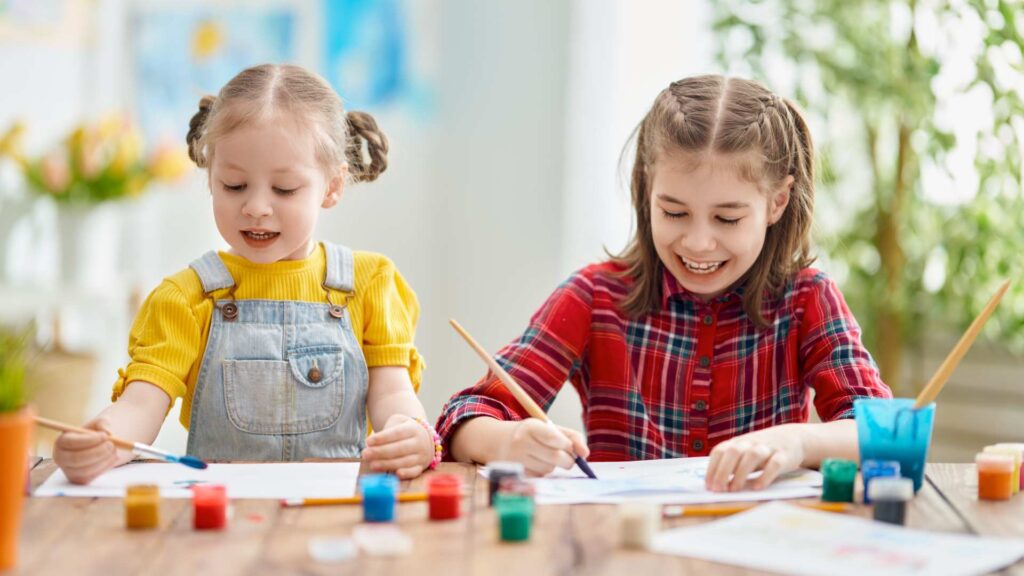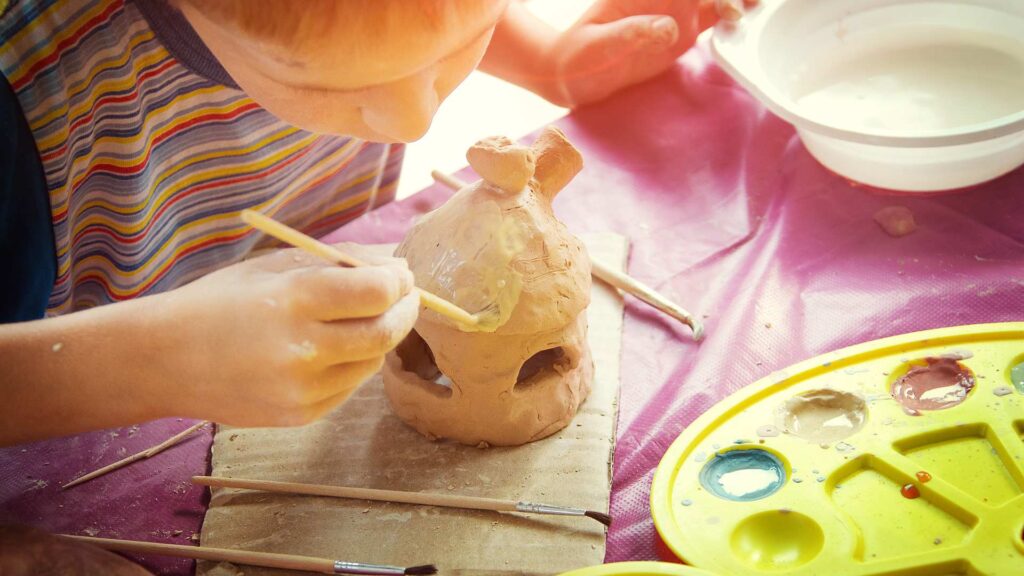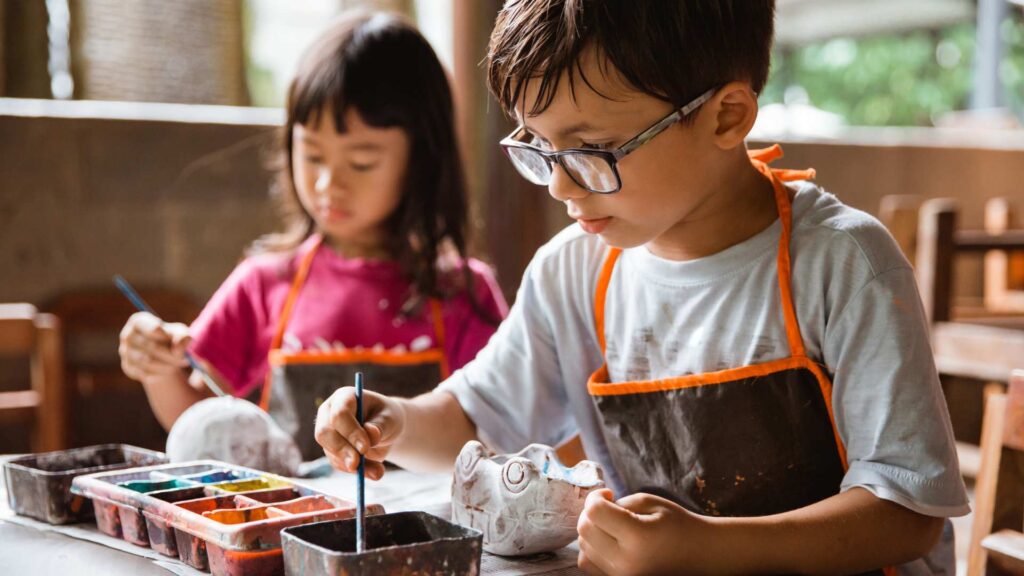Table of Contents
What are the benefits of art therapy in ASD?
Navigating the path after an autism spectrum disorder (ASD) diagnosis involves exploring various supportive strategies to enhance the development and well-being of your loved one. Among these, art therapy in autism has emerged as a compelling and innovative approach, offering unique benefits and a “voice” for those on the spectrum who struggle with communication.
Now, you are probably wondering: “What are the benefits of art therapy in ASD?” Autism, characterized by challenges in communication, social interaction, and repetitive behaviors, presents unique hurdles. Art therapy offers a creative outlet that can foster expression, communication, and emotional regulation, thereby providing a holistic approach to addressing the complexities of autism.
Keep reading this blog by ABA Centers of Pennsylvania. We will tell you how families in King of Prussia, Philadelphia, and other areas of Pennsylvania apply artistic processes with therapies to optimize results.
Understanding ASD Challenges
According to the CDC, autism is a neurodevelopmental condition that disrupts neurological development, potentially affecting various brain functions and causing challenges in social, cognitive, and emotional functioning. Many individuals on the autism spectrum experience a range of unique challenges, which can manifest in diverse ways.
For instance, some may struggle with both verbal and non-verbal communication, hindering their ability to express thoughts and emotions. Others may face intense sensory sensitivities, becoming overwhelmed by everyday stimuli such as bright lights, loud noises, or unusual textures. Furthermore, difficulties in social interaction and understanding social cues can impede the formation of meaningful relationships and the development of social skills.
It is crucial to identify these specific challenges for each individual, as each person may have unique needs and preferences. One way to achieve this is by observing the individual’s behaviors and responses in different situations. How do they react to certain sensory stimuli? How do they engage with others? What activities or environments appear to calm or interest them?
By understanding these challenges while also identifying the individual’s interests and preferences, we can create a more effective and person-centered therapeutic approach. For example, suppose a child demonstrates a strong interest in art or music. In that case, we can leverage those passions to introduce artistic or musical therapies that not only address their difficulties but also foster their engagement and enjoyment in the process.
What is Art Therapy?
Now, continuing with the various therapies that can complement children’s programs, art therapy is gaining more prominence as an alternative, creative, and safe means of self-expression.
Art therapy, as explained by the American Art Therapy Association, is a therapeutic approach that utilizes the creative process and artistic expression as tools to promote emotional well-being, self-expression, and personal growth. This form of therapy works as a non-verbal communication medium that allows individuals to explore their thoughts, emotions, and experiences in a safe and non-judgmental manner.
Art therapists assist clients in expressing themselves and processing their feelings using a variety of artistic mediums, such as painting, drawing, sculpture, collage, and music, among others. Through artistic creation and subsequent reflection on the produced work, individuals can gain a greater understanding of themselves, improve their self-esteem, develop coping skills, and address emotional issues.
Role of Art Therapy in Autism
Art therapy in autism can address a variety of needs. For instance, the study by the American Journal of Occupational Therapy explores how occupational therapists can effectively use creative arts interventions to assist children with ASD. Moreover, researchers found that drawing and painting, music, and theater interventions showed efficacy for children with ASD, mainly targeting the domains of performance skills and client factors. Interestingly, no single art form appeared superior, indicating that various creative arts activities offer similar benefits regardless of whether they are delivered individually or in groups.

Here are some ways in which art therapy can play an essential role for children on the spectrum:
Non-verbal communication: Communication difficulties are a common trait in autism. Art therapy provides an alternative means of expression that does not rely on verbal language. Through art, individuals on the spectrum can communicate their thoughts, emotions, and experiences in a way that feels safe and accessible to them.
Emotional exploration: Art therapy in autism offers a safe space for individuals to explore and process their emotions. By working with different artistic mediums, they can externalize and shape their feelings, allowing them to understand their own emotional experiences better.
Development of social skills: Group art activities can encourage social interaction and teamwork, providing opportunities for individuals with difficulty relating to others to practice social skills such as taking turns, sharing materials, and collaborating on projects.
Sensory regulation: Some individuals on the autism spectrum may have intense sensory sensitivities. Art therapy can help them regulate their sensory responses by interacting with different textures, colors, and materials in a controlled and therapeutic manner.
Art Therapy Activities for Autism
Prior to engaging in artistic activities with your child, the guidance of a therapist can prove beneficial. It is also essential to consider your child’s individual needs, difficulties, and preferences before initiating any art therapy activity.

Here are some creative processes that can be highly beneficial:
1. Finger painting – Finger painting is a sensory -stimulating activity that can be especially beneficial for individuals with autism. Provide a variety of paint colors and large paper for the individual to experiment with different textures and finger movements.
2. Emotion collage – This activity can help kids explore and express their emotions visually. Provide magazines, scissors, glue, and paper, and ask them to cut out images representing different emotions (joy, sadness, anger, etc.) and paste them onto a collage.
3. Clay sculpting – Working with clay is a tactile and therapeutic activity that can help regulate their sensory responses and develop fine motor skills. Provide different colors of clay and guide your kid to shape simple forms or even figures representing emotions or personal experiences.
4. Self-portrait drawing – This activity can help individuals with autism develop greater self-awareness and understanding of their emotions. Ask them to draw themselves and then add details describing how they feel at that moment. This representation may include facial expressions, body gestures, or elements from their surroundings associated with their emotions.
5. Music and movement – Music can be a powerful therapeutic tool for basically anyone! Organize music and movement sessions where kids can experiment with different musical instruments, rhythms, and body movements. This experience can help them regulate their mood, express emotions, and improve motor coordination.
Integrating Art Therapy with ABA Therapy
Integrating art therapy into the ABA program offers a holistic and comprehensive approach to autism treatment. By using artistic activities as reinforcers during ABA sessions, desired behavior can be motivated, and individuals can be encouraged to participate actively. It provides an additional avenue for communication and emotional expression, complementing the traditional communication strategies used in ABA and allowing individuals to express their thoughts and feelings more fully.
Furthermore, group art activities within the context of ABA provide opportunities to develop social skills. By working together on artistic projects, individuals can practice social skills such as taking turns, sharing materials, and collaborating as a team. This social interaction in a therapeutic and controlled environment promotes social inclusion and the development of positive relationships.
Personalized Treatment with ABA Centers of Pennsylvania
At ABA Centers of Pennsylvania, we recognize the value of artistic practices and incorporate them into our clients’ personalized ABA plans. By observing their strengths and weaknesses together, we create clear objectives to develop them with a behavioral yet enjoyable approach.
Offer your child the support they need to learn integral and essential life skills. Call us at (844) 444-7496 or leave us a message on our website to learn about the benefits of science-backed therapy.








